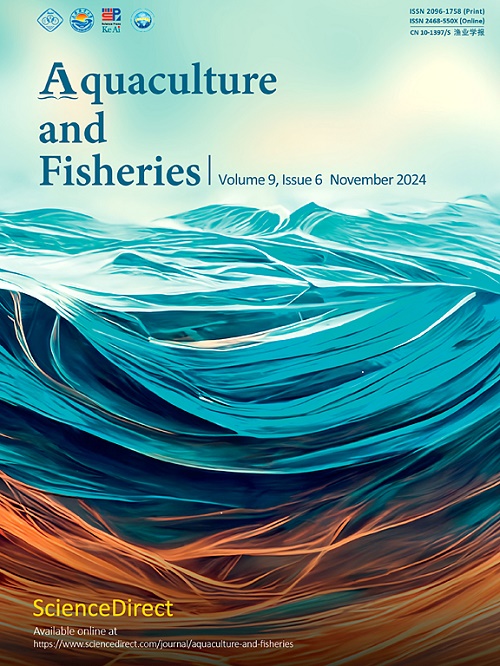孟加拉国尼罗罗非鱼(Oreochromis niloticus)鳃和肠以及水产养殖池塘水和沉积物中的异质性细菌群落
Q1 Agricultural and Biological Sciences
引用次数: 0
摘要
罗非鱼水产养殖对人类的营养需求有重大贡献。由于微生物在维持宿主的生理生化方面起着关键作用,因此研究与罗非鱼相关的微生物组以及养殖池水和沉积物中的微生物组有助于提高产量。利用16S rRNA基因扩增子测序技术,对尼罗罗非鱼鳃、肠道以及养殖池水和底泥中的细菌群落结构进行了研究。在所有样品中共鉴定出9770个细菌操作分类单位(OTUs)。沉积物样品产生3884个独特的otu, α -多样性水平最高(Shannon指数,P <;0.01)。罗非鱼鳃中梭杆菌属(59%)占主导地位,构成指示门;水(52%)、沉积物(28%)和肠道(33%)中变形杆菌属占主导地位。鳃和肠道的细菌群落结构与周围水和沉积物的细菌群落结构不太相似,可能是由于宿主特有的微生物选择。罗非鱼鳃和肠道中有益菌群占70%以上,致病菌占10%左右。本研究旨在探索孟加拉国罗非鱼养殖的微生物群落,结果表明罗非鱼鳃和肠道的微生物群落处于益生状态,这表明尼罗罗非鱼养殖处于健康状态,可以更好地生长和生产。本文章由计算机程序翻译,如有差异,请以英文原文为准。
Heterogeneous bacterial communities in gills and intestine of Nile tilapia (Oreochromis niloticus) and in water and sediments of aquaculture ponds in Bangladesh
Tilapia aquaculture contributes significantly to the nutritional requirements of humans. Because microbes play a pivotal role in maintaining the host's physiology and biochemistry, research on the microbiomes associated with tilapia and in the rearing pond water and sediment can contribute to increased production. We applied 16S rRNA gene amplicon sequencing to elucidate the bacterial community structures in the gills and intestine of Nile tilapia as well as in the water and sediment of their rearing ponds. We identified a total of 9770 bacterial Operational Taxonomic Units (OTUs) in all the samples. The sediment samples, which generated 3884 unique OTUs, had the highest level of alpha-diversity (Shannon index, P < 0.01) among all the samples. Fusobacteria (59%) predominated and constituted the indicator phylum in tilapia gills, while Proteobacteria was prevailed in water (52%), sediment (28%), and intestine (33%). The bacterial community structures of the gills and intestine were not much similar to those of the surrounding water and sediment, probably due to host-specific microbial selection. More than 70% of the bacterial flora were beneficial, whereas nearly 10% were pathogenic in gills and intestine of tilapia. This study aims to explore the microbiome of tilapia aquaculture in Bangladesh, and the results suggest that the microbial communities in tilapia gills and intestine are in a eubiotic state, which indicates a healthy state for better growth and production of Nile tilapia aquaculture.
求助全文
通过发布文献求助,成功后即可免费获取论文全文。
去求助
来源期刊

Aquaculture and Fisheries
Agricultural and Biological Sciences-Aquatic Science
CiteScore
7.50
自引率
0.00%
发文量
54
审稿时长
48 days
期刊介绍:
 求助内容:
求助内容: 应助结果提醒方式:
应助结果提醒方式:


